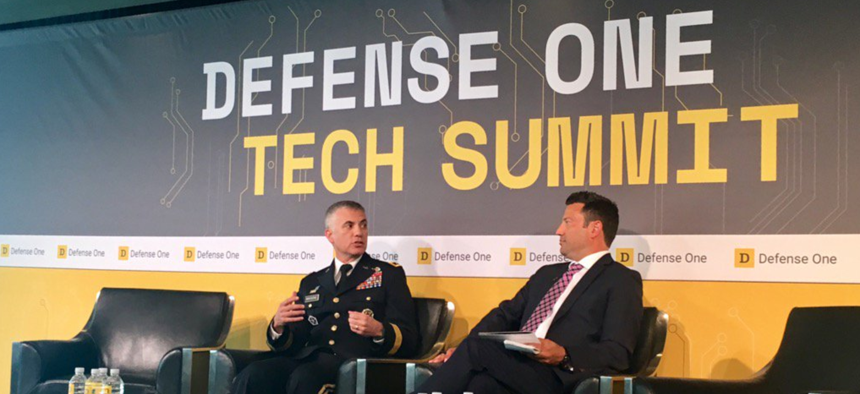
Army Lt. Gen. Paul Nakasone talks at the 2nd Annual Defense One Tech Summit on July 13, 2017, in Washington, D.C. Daniela Fayer
US Army Looking to Integrate Network Soldiers with Tactical Units
Brigades are working out various ideas at training centers, says the head of the service’s Cyber Command.
Bringing network-attack-and-defense skills to tactical units is the next step in the evolution of U.S. Army cyber capabilities, the head of the service’s Cyber Command said.
“We’re going to have some capability there — whether it’s resident permanently at a brigade combat team or a division or a corps, but it’s where we see the future,” Lt. Gen. Paul Nakasone said Thursday at the Defense One Tech Summit in Washington, D.C.
Nakasone leads 41 Army Cyber Mission Force Teams, a good chunk of the 133 teams coordinated by U.S. Cyber Command that reached initial operating capability last year. Initially, the Army created these specialized groups “just like the other services, really for the flavor of joint operations,” he said.
Now, Nakasone said, it’s time to begin figuring out how the Army can decentralize that capability. And they’re not alone. The U.S. Air Force has begun pushing cyber responsibilities down to the squadron level as well.
“The Army has now looked at it and said, ‘What do we need at the tactical level? What does a brigade combat team need?’” he said.
The service has begun figuring out the answers to those questions, conducting seven rotations at combat training centers, looking at “what might a brigade commander do in social media, how do they better defend their networks, and what are the capabilities that they need for reach back to be able to prosecute a target.”
There’s still a lot to be decided, but tactical leaders are ready.
“Certainly, what our initial findings from our rotations is that brigade commanders can take this information and they can synchronize it along with all the other enablers they have,” Nakasone said.
It’s not all about offense. The most difficult thing Army Cyber Command does is operate and defend its networks and weapons, Nakasone said. A team of about “30 to 40 folks” spend their days seeking out vulnerabilities and fixing them, guarding against intrusions, and providing early warning.
“Whether or not you’re on the far reaches of Eastern Europe or any place deployed today, even in the United States, we see a number of different intrusions every day,” he said. How many? “Tens, hundreds of thousands a day.”




